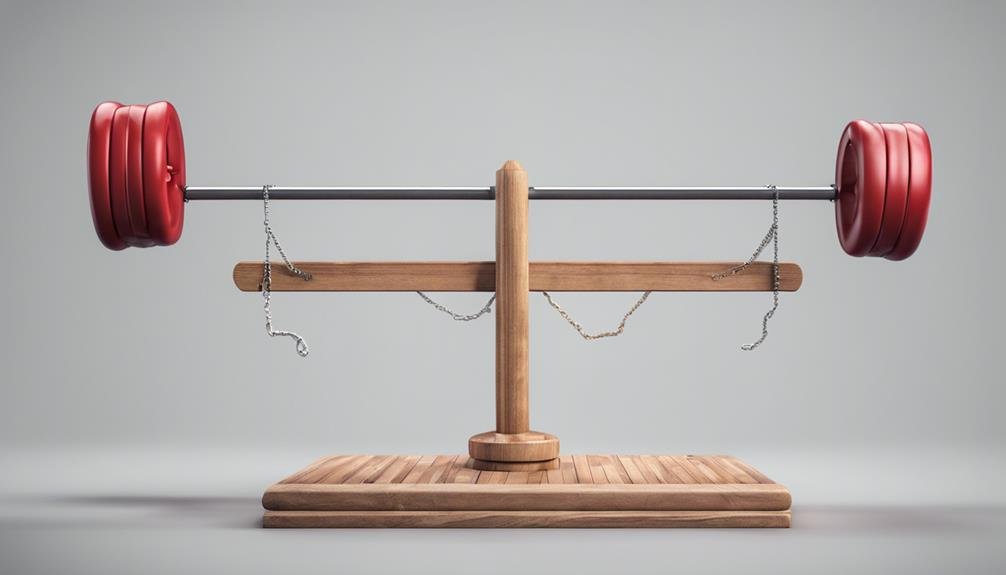Inflation and Deflation Dynamics
Understand the push and pull of inflation versus deflation dynamics. Inflation sees rising prices due to factors like demand and production costs. Rising inflation erodes savings and purchasing power. Meanwhile, deflation is persistent price decreases leading to reduced spending and demand. Central banks manage inflation through monetary policies. While deflation can stem from global trade disruptions and decreased consumer spending. These economic fluctuations shape markets and dictate consumer behaviors. Further insights await on the intricate interplay between these forces and their impact on the economy.
Key Takeaways
- Inflation impacts economies globally through rising prices and eroding purchasing power.
- Deflation leads to price decreases, impacting consumer sentiment and economic activity.
- Factors driving inflation include monetary policy, demand-supply imbalances, and production costs.
- Causes of deflation include economic downturns, reduced spending, and global trade disruptions.
- Effects of inflation include reduced purchasing power, increased costs, and wealth redistribution.
The Basics of Inflation
Understanding how inflation impacts economies globally is essential for making informed financial decisions. One key metric used to measure inflation is the Consumer Price Index (CPI). The CPI tracks the average change over time in prices paid by consumers for goods and services, providing vital insights into price level fluctuations within an economy.
When the CPI rises, it indicates that the cost of living is increasing, leading to a decrease in purchasing power for consumers. This can have various implications, such as eroding savings and reducing overall economic growth. Price levels fluctuate due to a variety of factors, including changes in demand, production costs, and monetary policies.
Understanding Deflation
With deflation, prices in an economy are experiencing a persistent decrease, leading to a dilemma for policymakers and businesses alike. Deflation psychology plays an important role in exacerbating this phenomenon, as consumer sentiment can shift towards delaying purchases in anticipation of further price drops. This behavior can create a harmful cycle where reduced consumer spending leads to lower demand, prompting businesses to lower prices even more to stimulate sales.
Moreover, deflationary pressures are often intertwined with global trade dynamics. In a scenario where prices are falling domestically, businesses may look to international markets to maintain profitability. This can result in increased competition with foreign firms, further driving down prices both at home and abroad.
Understanding deflation requires a nuanced approach that considers not only economic indicators but also the psychological aspects influencing consumer behavior and the interconnectedness of global trade. Policymakers need to navigate these complexities carefully to prevent deflation from becoming entrenched in an economy.
Factors Driving Inflation
Inflation in an economy is primarily driven by a combination of factors such as monetary policy, consumer demand, and supply chain disruptions. Monetary policy, set by central banks, plays an essential role in controlling inflation through interest rates and money supply adjustments. When demand from consumers surpasses the available supply of goods and services, it leads to a situation where prices rise, causing inflation. Additionally, supply chain disruptions, like those experienced during the COVID-19 pandemic, can result in shortages and increased production costs, further fueling inflationary pressures.
The consequences of these inflation-driving factors can be significant. High inflation erodes the purchasing power of the currency, leading to a decrease in real wages and savings. It can also create uncertainty in the economy, making it challenging for businesses to plan for the future. Besides, inflation can have distributional effects, impacting different groups within society disproportionately. Understanding these factors driving inflation is essential for policymakers to implement appropriate measures to maintain price stability and sustainable economic growth.
Causes of Deflation
When contemplating the reasons for deflation, it's imperative to analyze the effects of economic downturns, the decrease in consumer spending, and the potential risks associated with a deflationary spiral.
These factors play significant roles in driving the downward trend in prices and economic activity.
Understanding the interplay between these elements is essential for grasping the complexities of deflation dynamics.
Economic Downturn Effects
During times of economic downturn, deflation can be triggered by a combination of reduced consumer spending, declining business investments, and a contraction in the money supply. The interplay of these factors can lead to a downward spiral in prices as demand weakens and businesses cut back on production. In such scenarios, unemployment rates tend to rise, exacerbating the recession outlook.
To explore further into the causes of deflation during economic downturns, it's essential to take into account the impact of global supply chains and trade imbalances. Disruptions in global trade can lead to excess inventory levels, forcing companies to lower prices to clear out stock. Additionally, trade imbalances can result in competitive pressures that dampen prices on imported goods, contributing to deflationary pressures.
| Factors Contributing to Deflation During Economic Downturns | Effects |
|---|---|
| Reduced consumer spending | Weak demand and downward pressure on prices |
| Declining business investments | Production cuts and decreased pricing power |
| Contraction in the money supply | Limited access to credit and reduced spending capacity |
Reduced Consumer Spending
Amid an economic downturn, the reduction in consumer spending plays a pivotal role in driving deflationary pressures by weakening demand and exerting downward pressure on prices. Consumer confidence and market trends heavily influence spending patterns, which in turn impact various economic indicators.
- Consumer Confidence: When consumers are uncertain about the future economic conditions, they tend to reduce their spending, leading to a decrease in overall demand for goods and services.
- Market Trends: Shifts in market trends can greatly affect consumer behavior, influencing how much individuals are willing to spend on non-essential items.
- Spending Patterns: Changes in spending patterns, such as a preference for saving rather than spending, can contribute to reduced consumer spending, further exacerbating deflationary pressures.
- Economic Indicators: Indicators like personal income, employment levels, and inflation rates can impact consumer spending habits, thereby affecting the overall deflationary environment.
Deflationary Spiral Risks
Investigating the root causes of deflation, particularly the risks associated with a deflationary spiral, reveals critical economic dynamics that warrant close examination. Deflationary risks pose significant threats to economic growth, creating a downward spiral that can be challenging to reverse. One key factor contributing to a deflationary spiral is the decrease in consumer demand, leading to lower prices, reduced production, and ultimately, higher unemployment rates. Additionally, deflation can be fueled by excessive debt levels, as individuals and businesses struggle to repay loans in an environment of falling prices.
To illustrate the complexities of deflationary risks, consider the following table highlighting the main causes and impacts of a deflationary spiral:
| Causes of Deflationary Spiral | Impacts on the Economy |
|---|---|
| Decreased consumer spending | Lower production levels |
| Excessive debt levels | Rising unemployment |
| Contraction in monetary policy | Deflationary pressures |
| Weak global demand | Economic stagnation |
| Asset price deflation | Reduced investment |
Understanding these factors is essential for policymakers to implement effective monetary policies and prevent the economy from entering a prolonged period of deflation.
Effects of Inflation
When inflation occurs, it impacts various aspects of the economy, influencing consumer purchasing power and overall price levels. This has significant consequences on consumer choices and investment decisions. Here are some key effects of inflation:
- Reduced Purchasing Power: Inflation erodes the value of money, leading to a decrease in what each unit of currency can buy. This reduction in purchasing power can affect consumers' ability to afford goods and services.
- Increased Costs: Inflation often leads to higher production costs for businesses, which can result in price hikes for consumers. This can create a cycle where rising prices further fuel inflation.
- Interest Rates: Inflation can influence central banks to raise interest rates to curb rising prices. Higher interest rates can impact borrowing costs, affecting both consumers and businesses.
- Asset Valuations: Inflation can impact the values of assets such as real estate, stocks, and bonds. Investors may need to adjust their investment strategies to mitigate the effects of inflation on their portfolios.
Impact on Consumer Behavior
Consumer behavior undergoes significant shifts in response to the fluctuations caused by inflation and deflation dynamics. These changes are highly influenced by consumer sentiment and spending patterns.
When inflation rates rise, consumers often feel less optimistic about the economy, leading to a decrease in their confidence levels. This decline in consumer sentiment can result in altered spending patterns, with individuals becoming more cautious about their purchases. As prices increase, consumers may prioritize essential goods over luxury items, impacting various industries differently.
Conversely, during deflationary periods, where prices are declining, consumer sentiment may initially improve due to perceived cost savings. However, prolonged deflation can lead to a decrease in spending as consumers anticipate even lower prices in the future. This shift in spending patterns can have cascading effects on businesses, with some experiencing reduced demand for their products or services.
Understanding how inflation and deflation dynamics affect consumer behavior is vital for businesses and policymakers to adapt their strategies effectively. By monitoring consumer sentiment and spending patterns, stakeholders can better anticipate market trends and tailor their approaches to mitigate the impacts of these economic fluctuations.
Policy Responses to Inflation
When facing inflation, policymakers typically resort to monetary tightening measures, such as increasing interest rates, to curb excessive money supply and demand.
Additionally, governments may implement price control regulations to prevent rapid price escalations in essential goods and services.
Demand management strategies, like fiscal policies and incentives, can also be employed to stabilize consumer spending and overall economic activity.
Monetary Tightening Measures
To combat rising inflation, central banks often implement monetary tightening measures, adjusting interest rates and reducing the money supply to curb excessive price increases. When central banks decide to tighten monetary policy, they aim to slow down economic growth to prevent inflation from spiraling out of control.
Here are some key measures central banks may take:
- Increasing Interest Rates: By raising interest rates, central banks make borrowing more expensive, reducing consumer spending and business investment.
- Open Market Operations: Central banks can sell government securities to commercial banks, reducing the money supply in the economy.
- Reserve Requirements: Adjusting the amount of reserves commercial banks are required to hold can impact the money available for lending.
- Forward Guidance: Central banks can communicate their intentions regarding future monetary policy to influence market expectations.
These measures are carefully orchestrated by central banks to strike a balance between controlling inflation and maintaining economic stability.
Price Control Regulations
Implementing price control regulations is a common policy response to inflation, aiming to stabilize prices and mitigate the impacts of rising costs on the economy. Government intervention through price controls involves setting maximum or minimum prices for goods and services to prevent rapid price increases. These regulations can be imposed on essential items like food and fuel to guarantee affordability for consumers. While price controls may initially appear effective in controlling inflation, they can lead to unintended consequences such as shortages, black markets, and reduced investment in production.
The effectiveness of price control regulations in maintaining market stability is a topic of debate among economists. Proponents argue that these measures protect consumers from price gouging during inflationary periods. However, critics suggest that government intervention distorts market mechanisms, leading to inefficiencies and hindering long-term economic growth.
Finding the right balance between regulating prices and allowing market forces to operate freely is pivotal for policymakers when considering price control regulations as a strategy to combat inflation. It's essential to weigh the short-term benefits of stabilizing prices against the potential long-term consequences of disrupting market dynamics.
Demand Management Strategies
Effective demand management strategies are essential in addressing inflationary pressures and maintaining economic stability. When facing supply chain disruptions or market fluctuations, implementing appropriate measures becomes important. Here are some strategies to contemplate:
- Monetary Policy Adjustments: Central banks can use interest rates to influence spending and borrowing, helping to control inflation by either tightening or loosening monetary conditions.
- Fiscal Policy Interventions: Governments can adjust taxation and public spending to manage aggregate demand, curbing inflationary pressures in times of rapid economic growth.
- Supply-Side Policies: Investing in infrastructure, technology, and education can enhance productivity, mitigating inflationary effects stemming from supply constraints.
- Income Policies: Regulating wage growth and income distribution can impact consumer spending, influencing overall demand levels and inflation dynamics.
Strategies to Combat Deflation
In combating deflation, it is essential to adopt strategic measures that stimulate demand and encourage spending in the economy. Two primary tools commonly employed are fiscal stimulus and monetary policy. Fiscal stimulus involves the government increasing spending or reducing taxes to boost demand. On the other hand, monetary policy, controlled by central banks, involves actions like lowering interest rates or implementing quantitative easing to spur borrowing and investment.
To effectively combat deflation, a combination of these strategies is often utilized. Here is a comparison table highlighting the key differences between fiscal stimulus and monetary policy:
| Aspect | Fiscal Stimulus | Monetary Policy |
|---|---|---|
| Control | Government | Central Bank |
| Tools | Increased government spending, tax cuts | Interest rate adjustments, quantitative easing |
| Impact on Debt | May increase government debt | Can affect long-term interest rates |
Balancing Inflation and Deflation
To achieve a balanced approach between inflation and deflation, policymakers must carefully calibrate economic measures to maintain stable price levels and sustainable growth. Striking the right balance is vital to guarantee a healthy economic environment that fosters prosperity and stability.
In managing price stability, it's essential to take into account both inflation targeting and deflation risk mitigation strategies. By implementing effective policies, policymakers can navigate the complexities of inflation and deflation dynamics, steering the economy towards a path of equilibrium.
Here are key considerations for balancing inflation and deflation:
- Utilize Inflation Targeting Mechanisms: Setting clear inflation targets can help guide monetary policy decisions and anchor inflation expectations.
- Implement Flexible Monetary Policies: Adaptability in monetary policies allows for timely responses to changing economic conditions, reducing the risk of deflationary pressures.
- Promote Sustainable Economic Growth: Fostering economic growth while ensuring price stability is vital for long-term prosperity.
- Monitor Price Indices Closely: Regular monitoring of price indices provides valuable insights into inflationary or deflationary trends, facilitating informed policy adjustments.
Conclusion
In summary, comprehending the dynamics of inflation and deflation is essential for maneuvering the intricate world of economics.
Have you considered how these forces impact your daily life and financial decisions?
By staying informed and aware of the factors driving inflation and causes of deflation, you can better prepare yourself for the potential effects on consumer behavior and policy responses.
Striking a balance between inflation and deflation is key to maintaining a stable economy.








